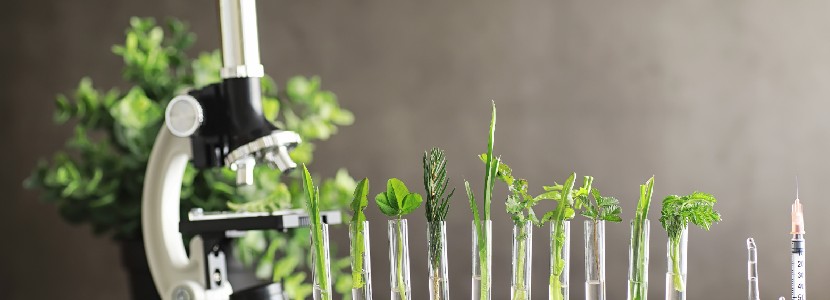 09 Jun 2022
09 Jun 2022
Phytochemicals and their inclusion in animal feed has been proposed as a replacement for traditional growth promoters over various decades now. However there are still doubts regarding their true worth within animal production.
Introduction
The use of growth promoters has been widely implemented as a strategy for improving productivity within the meat production industry in the past decades. With the aim of improving parameters like weight gain and feed efficiency the positive effects of these compound have met the needs of both the primary sector within the meat production chain as well as impacting the industrial sector and consumers.
Under such scenario, increased yields of prime cuts and reductions in intramuscular fat deposition have lead to leaner cuts that satisfy the demands of modern consumers. However, due to the significant human and animal health risks associated with antimicrobial resistance, the use antibiotic growth promoters (AGPs) has been banned in several countries. This has also lead to an increased number of consumers who are concerned about their food quality and security above all. Therefore, the use of synthetic chemicals, such as (AGPs) which were regularly used in the livestock and meat production industry, have become highly rejected by the public.
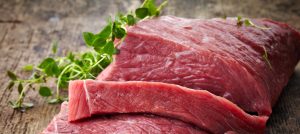
In addition to this situation, there is a constant outcry from producers regarding commercial and market failures due to the adoption of laws that ban the use of traditional growth promoters such as AGPs. Such factors, have triggered an active search for alternatives that can replace synthetic growth promoters and be able to offer similar yield benefits.
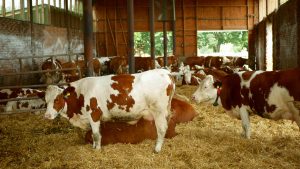
Current status of growth promoters
Currently there is a wide range of growth promoters, mostly of synthetic origin, which are used throughout almost all stages of animal production. However, the search for alternatives has always and even at present, focused on antibiotics. Ignoring other compounds used in the finishing phases of animal production. It is under such context that secondary plant metabolites, such as phytochemicals, have emerged as potential growth promoter alternatives. Despite the fact that such compounds have been around for some time now their effects on performance have given inconsistent results and this has led to doubts regarding their use. However, most research has focused on analyzing the effects of phytochemicals on animal productivity when used as dietary supplements, neglecting the benefits of growth promoters throughout the whole production chain. It is necessary to readjust expectations and understand the effects of phytochemical feed additives throughout the different stages of the meat production chain in order develop strategies that result in real optimization and productivity gains.
The following entry aims to offer a review of some of the current knowledge regarding the dietary inclusion of phytochemicals as animal growth promoters for cattle, pigs and poultry. Touching base on some of the current strategies used for their inclusion in animal production systems and what are some of their action mechanisms.
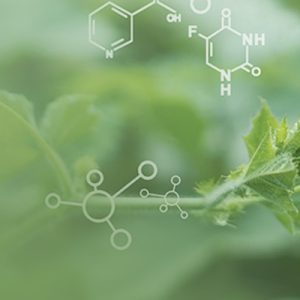
Types of Phytochemicals currently used
The active compounds found in plants have a wide variation depending on intrinsic factors, such as: part of the plant which is used, harvest season and the geographical origin of such plants. There are also extrinsic factors that affect the potential effects of such compounds when used as dietary additives, like the production processes that they submitted to.
Phytochemical feed additives are an extremely large group of compounds with great diversity in chemical structure and bioactivity. The diversity of plant by-productsis also the result of evolutionary processes through which plants have developed defense mechanisms against threats from microorganisms, insects, and other animals. Phytochemicals present several biological properties that make them attractive to be used use as growth promoters in animal production. These include:
A wide variety of phytochemical feed additives have been used experimentally in animal production. However, there is still confusion regarding the definition of what phytochemical additive is and if for example an entire plant should be considered as such. Several authors have proposed different classifications based on factors like: botanical origin, composition and processing, while others propose to base their classification on mechanisms of action. Yet, regarding the latter method, some phytochemicals present a wide range of biological activities and mechanisms through which they exert their effects complicating their classification.
Previous studies regarding the use of phytochemicals to replace traditional growth promoters have focused mainly on the early stages of animal production, while completely disregarding their use in finishing phases. This is mainly true for pig and cattle production. The following figure contains some examples.
Figure 1: Proposed classification and examples of phytochemicals used as growth promoter additives
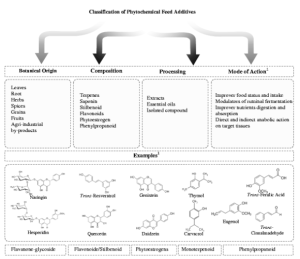
Mechanisms of Action
Despite the fact that phytochemicals have been used for a long time as flavoring agents, medicines, and food preservatives, their action mechanisms are still not well known. Based on the different known biological activities of phytochemicals, four main mechanisms have been proposed to support the observed physiological changes in studied animals. Also aiming to explain the effects on growth performance, carcass characteristics and meat quality.
The four proposed mechanisms are:
Figure 2: Schematic description of main mechanism of action and effects of dietary phytochemicals feed-additives
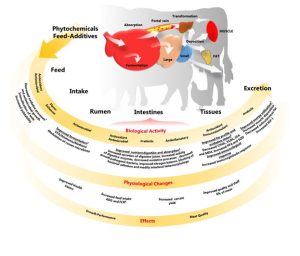
The mechanism of action for a specific phytochemical feed additive mainly depends on its structure, dosage, and pharmacokinetics, as well as the animal species, productive stage and administration period in which it is employed. On the other hand, growth promoting effects may be due to various mechanisms associated with different biological activities of phytochemicals. Yet there is still no clear report with information describing what determines various mechanisms within a same experiment. This may be due to a lack of studies on the mechanisms of a specific phytochemical on a specific species which highlights the need of more research on this subject.
This entry will be continued on a subsequent publication…
Subscribe now to the technical magazine of animal nutrition
AUTHORS

Nutritional Interventions to Improve Fertility in Male Broiler Breeders
Edgar O. Oviedo Rondón
The Use of Organic Acids in Poultry: A Natural Path to Health and Productivity
M. Naeem
Synergistic Benefits of Prebiotics and Probiotics in Poultry, Swine, and Cattle
Gustavo Adolfo Quintana-Ospina
Hybrid Rye Potential in Laying Hen Feed Rations
Gwendolyn Jones
A day in the life of phosphorus in pigs: Part I
Rafael Duran Giménez-Rico
Use of enzymes in diets for ruminants
Braulio de la Calle Campos
Minerals and Hoof Health in the Pregnant Sow
Juan Gabriel Espino
Impact of Oxidized Fats on Swine Reproduction and Offspring
Maria Alejandra Perez Alvarado